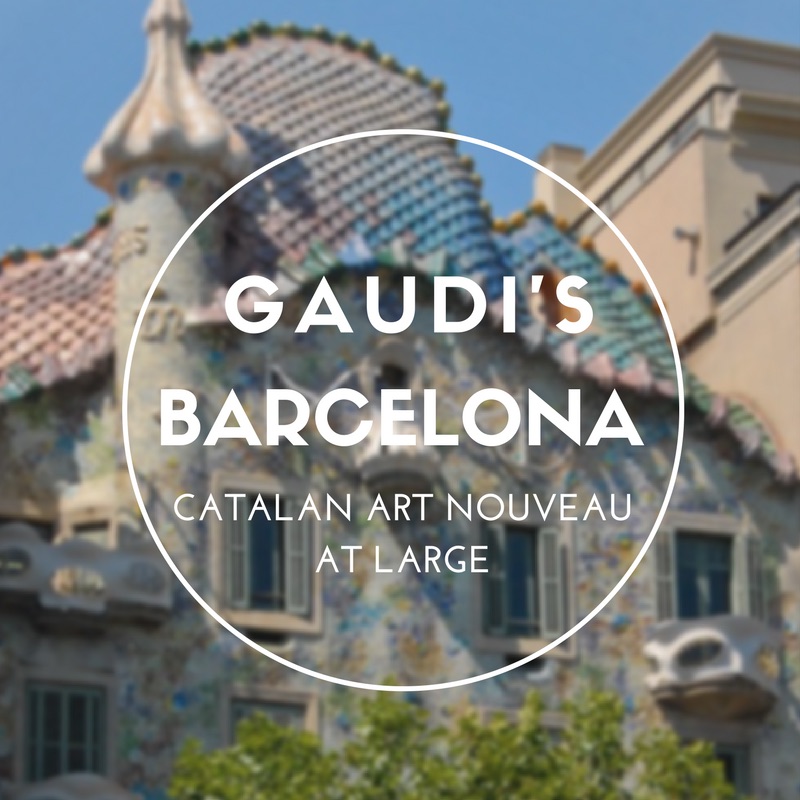Gaudi’s Barcelona
Catalan Art Nouveau at large
It’s time again for the ArtSmart Roundtable. This month the topic is Architecture. We therefore take you to Barcelona, Spain, for Gaudi‘s modernist architecture.
Each month the members of the ArtSmart Roundtable – a number of international art enthusiastic travel bloggers – delve into a topic on the crossroads of art and travel. Browse to the end of this article for the other contributions to this month’s ArtSmart Roundtable.
While gazing up the Sagrada Familia I could not help myself from thinking, what an ingenious mind its architect must have been. We are standing in front of the largest construction designed by Antoni Gaudi, yet to finish. From here we will start our Gaudi Tour through Barcelona.
(last update May 2017)
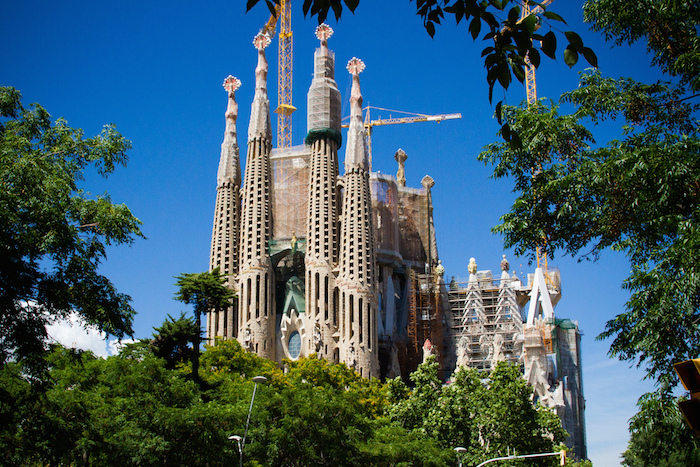
Sagrada Familia, Barcelona – (c) Flavio Ensiki. Flickr CC.
Getting to know Gaudi
The Catalan Antoni Gaudi (1852-1926) who nowadays is considered as one of Spain’s most renown architects, was not immediately seen as such. When graduating from the Barcelona School of Higher Architecture in 1878, his skills were still questioned by his professors. Soon after graduating he became more known for his modernist style though. Gaudi fairly quickly received commissions to design some of the constructions we nowadays recognize as the most important structures of modernist Barcelona, or what others refer to as Catalan art nouveau.
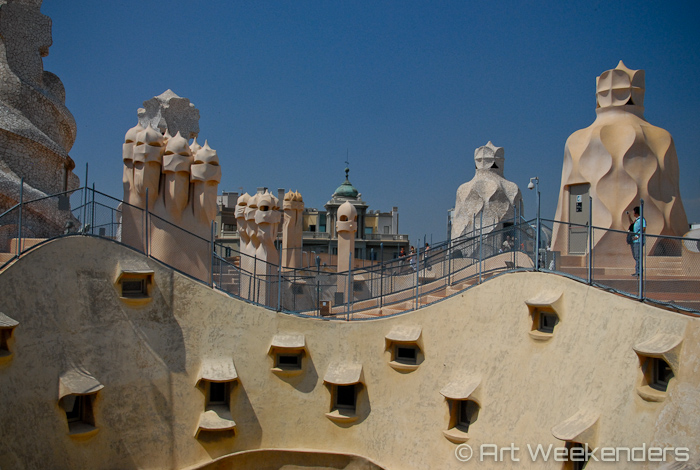
The rooftop of Casa Mila, Barcelona.
Contrary to the Art Nouveau movement in the rest of Europe, in Barcelona Modernism found its origin more in nationalistic pride than in anything else. In an economic climate where the rest of Spain was doing so-so, Barcelona was still thriving. The wealthy local upper-class wanted to promote the Renaixanca, the revival of Catalan traditions and the national culture. As a natural effect the preference for local artists was strong. This was likely also one of the reasons Gaudi quickly received important assignments throughout town.
Although Gaudi is seen as the main figure in the Catalan Modernism, his style went way further than that. Gaudi often found his inspiration in the geometric forms he encountered in nature, applying these into his architecture.
La Sagrada Familia
There are likely few other unfinished constructions around the world as famous as La Sagrada Familia, which unusually also got assigned a UNESCO World Heritage status already before its completion. The architect has now been dead for soon ninety years and the cathedral has been a work in progress ever since.
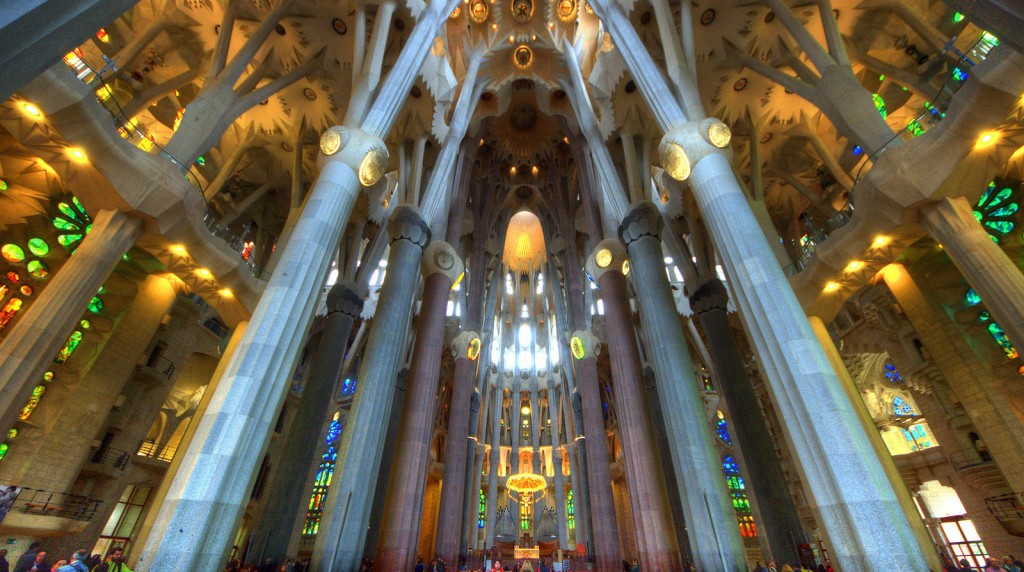
The inside of La Sagrada Familia, Barcelona – (c) Claude Attard. Flickr CC.
At the foundation of the construction of the Basílica i Temple Expiatori de la Sagrada Família (translated as the Basilica and Expiatory Church of the Holy Family) lays the idea of the bookseller Josep Maria Bocabella, founder of Asociación Espiritual de Devotos de San José. His idea was to build an expiatory church fully devoted to the Holy Family. Through generous donations the building of La Sagrada Familia commenced in 1882 initially under the architect Francisco de Paula del Villar. Soon after the start – in 1883 – he was replaced by Gaudi who never let go of the project until his death in 1926.
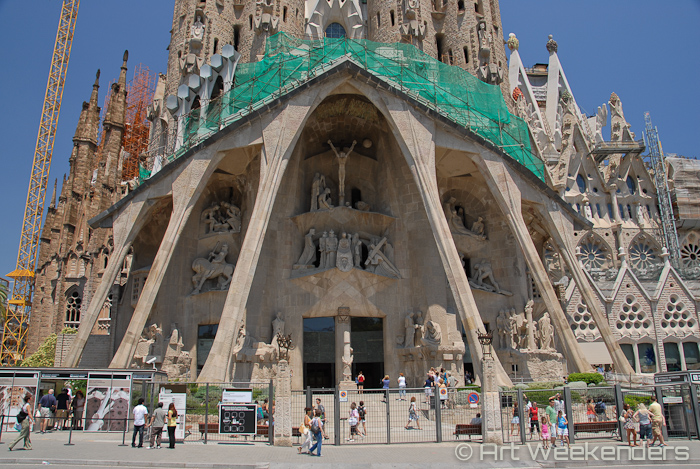
La Sagrada Familia, Barcelona.
Anticipating that he would not be able to finish the construction of La Sagrada Familia during his life Gaudi already designed the construction of the church in phases. In this way every generation would have a goal to finish one part. At the moment of his death only about a quarter of the church was finished.
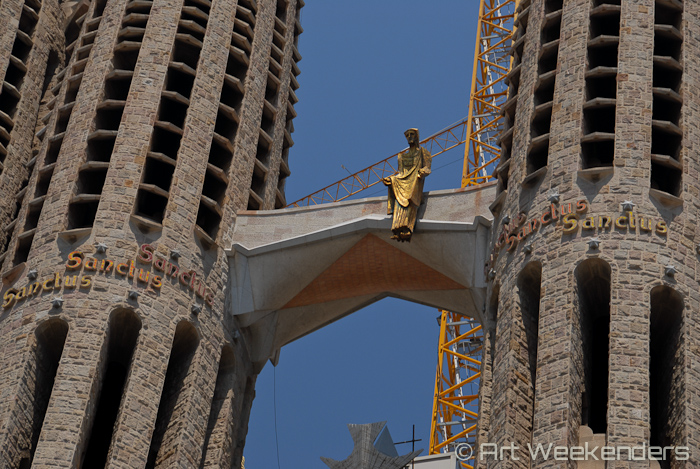
Details of La Sagrada Familia, Barcelona.
Some unfortunate incidents, such as the Spanish Civil War and lack of funds, almost caused the church never to be finished. Fortunately thanks to a large number of well-trained architects and private donations the work on the church continues up to date. These days the progress of the construction goes even a bit more quickly, thanks to the computer-aided design technology applied in the construction works. The church is said to be finished in between 2026 and 2030.
While seeing La Sagrada Familia itself from the outside is already a treat for the eye (make sure to walk around it), we can definitely recommend entering the church for a closer look. Repeated visits stay exciting due to the progress continuously made.
General information:
The entrance fee depends on which areas you’d like to visit (only the basilica or also one of the towers) and if you take part in a (audio) guide. Fees start as from €14,80. Click here for the details. By buying your tickets online, you can prevent hours of waiting. General opening hours to the Basilica are from 9.00 am to 6.00 pm from October to March and 9.00 am to 8.00 pm from April to September. Other parts of the church may be open a bit shorter. La Sagrada Familia is located at Mallorca, 401. Unless you’re walking, take the metro (L2 and L5), city bus (19, 33, 34, 50, 51 H10 and V21) or the tourist bus and get off at stop Sagrada Familia.
ParK Güell
Already early in his career Antoni Gaudi met the industrialist Eusebi Güell, who – immediately impressed by Gaudi’s modernist design – commissioned the architect to build various structures bearing his name. Some of the most famous are the Parc Güell, Palau Güell and the Crypt in Colonia Güell, the latter being 23 kilometers outside Barcelona.
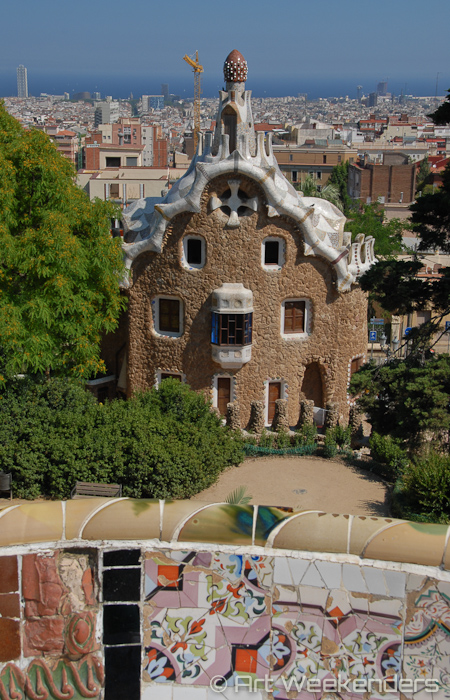
View from Parc Guell, Barcelona.
Parc Güell is one of those spots in Barcelona, where you can escape the hustling and bustling of the city. This is provided you walk a bit further than the entrance, which is one of the most popular parts of the park and thus often pretty crowded. The park – measuring 17.18 hectare and built between 1900 and 1914 – is full of beautiful architectural structures designed by Gaudi. Some parts are decorated with the colourful mosaics he often used in his work. Other parts are more of a rural shape, totally fitting in with the ambiance of a park. On top of it, from the higher parts of the park you have different, excellent views over the city. For a panoramic view search for the large cross at the high-point of the park.
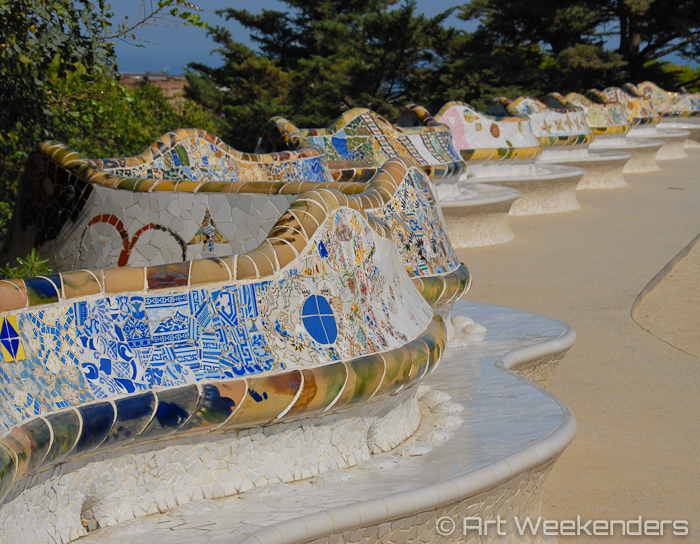
In Parc Guell, Barcelona.
In this park you also find the Gaudi House Museum, the house in which Gaudi lived from 1906 until 1926, and which by the way is not designed by him, but does contain furniture designed by the architect himself. Entrance to this museum is €5,50 (unless discounts apply).
General information:
Entrance to the outer areas of the park is free, but you will have to pay an entrance fee to enter the monumental zone, the main entrance and the parts containing mosaics. The monumental zone of the park is open from 8.00 am to 9.00 pm (1 May to 26 October), 8.00 am to 8.00 pm (24 March to 30 April) and 8.30 am to 6.00 pm (27 October to 23 March) Tickets can be bought online here or at the spot (respectively €7 or €8 unless discounts apply). Again, buy your ticket online, if you want to make sure to get in. There’s a limit to the number of people that are allowed to be in the monumental zone of the park at the same moment. The park is located at the hill El Carmel in the Gracia district. Take a metro (L3) to Vallcarca or Lesseps station from where it’s about a 15 minutes walk uphill (unless the escalators work) or – easier – take the bus (H6, 32, 24 or 92) to respectively Travessera de Dalt (H6, 32, 1o minutes walk), Place Catalunya (24) or Carretera del Carmel-Park Güell (92, stopping in front of the main entrance). For more specifics, click here.
Palau Güell
After having been closed for renovation for several years Palau Güell has opened again completely in 2011, adding an extra destination to our Gaudi Route in Barcelona.
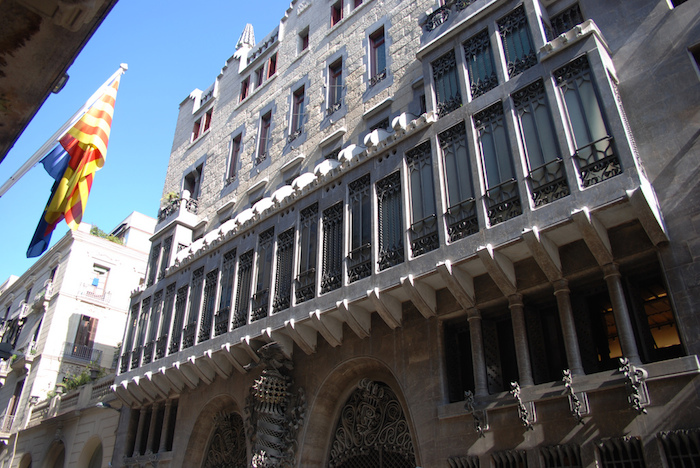
Palau Güell, Barcelona. (c) George M. Grouta. Flickr CC.
Palau Güell was designed and constructed by Gaudi in between 1885 and 1888 as a city palace for his patron and friend Eusebi Güell and is situated in the Raval neighbourhood on Carrer Nou de la Rambla (no. 3-5). Parts of its facade resemble a Venetian palace and the oval portals were the place where guests could enter the mansion with their horse and carriage, after which they would be guided to the upper floors where the family lived. You can see Gaudi’s typical playful design back in the whole building (including its colourful rooftop), its furniture and other ornaments. As the other Gaudi sites in this article Palau Güell is a UNESCO World Heritage Site.
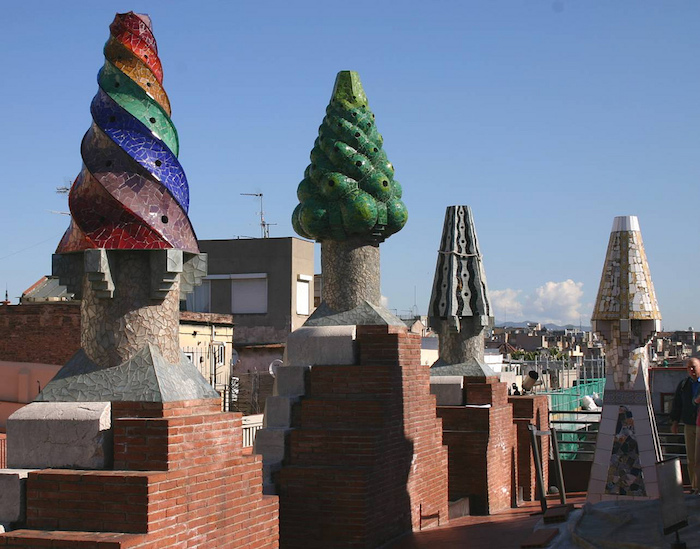
Palau Güell, Barcelona. (c) Frank Kovalchek. Flickr CC.
General information:
The entrance fee to Palau Güell is € 12,- (unless discounts apply, check here), an audio guide is included in the ticket price. Opening hours are: Tuesday to Sunday from 10.00am to 8.00pm (April to October) and 10.00am to 5.3opm (November to March).Also read: Barcelona or Madrid? How To Choose
Casa Battló
Casa Battló went trough a thorough renovation already at an earlier stage of its existence and thanks to the renovation being commissioned to Gaudi the building has gotten the fame it has today.

Casa Batllo, Barcelona
Casa Battló was built by the architect Emilio Sala Cortés in 1877 and was at that stage a typical classical building without the modernist characteristics we would see applied to it shortly after the turn of the century. When the ownership of the building changed in the early 1900s, Gaudi was asked to re-do the interior and exterior design, for which he got all creative freedom. Part of the result of this renovation is what we can nowadays see at Passeig de Gràcia number 43. Throughout the years more renovations and refurbishments have taken place. None really affected Gaudi’s stamp on the building though. With nicknames like the house of the bones, the house of the masks and the house of the dragon you can imagine the exterior is quite magnificent, as is the interior.
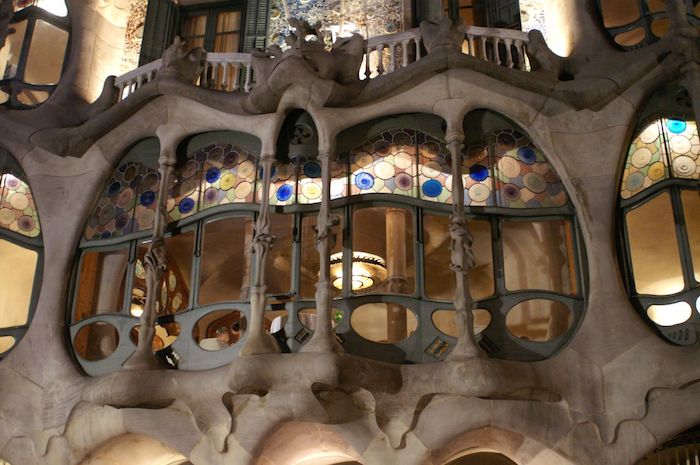
Casa Batllo, Barcelona. (c) Ferran Pestana. Flickr CC.
The 5,000 m2 building is no longer used for housing, instead it is being used for events and since 2002 made accessible for tourists.
General information:
The standard entrance fee is hefty with a €21.50, so have a look here if you or one of your companions would perhaps be able to get a discount, or if there is a special event going on. Audio-guides are available in ten languages. Opening hours are in general from 9.00 am to 9.00 pm from Monday to Sunday, 365 days a year. When you’re based in the city centre you’ll likely come across Casa Battló when walking around. If not, take the bus (no. 7,16, 17, 22, 24 or 28), metro (L2, L3 or L4) or train (RENFE) and get off at Passeig de Gracia.
Casa Mila (La Pedrera)
Casa Mila, locally more often referred to as La Pedrera (the stone quarry), is one of the other magnificent houses designed by Gaudi along the Passeig de Gracia, this one being located at the corner with Carrer de Provença (numbers 261-265). It was built by Gaudi for the wealthy family Mila at the height of his career in between 1906 and 1912 and seen as one of this most innovative works in terms of functional, decorative and constructive aspects.

Casa Mila (La Pedrera), Barcelona
The building consists of two separate buildings, structured around two courtyards, and was meant to be partially a house for the Mila family and partially apartments for rent.
Although the roof-terrace was mainly meant to fulfill a functional role, this doesn’t make it less spectacular. Walking around here you’ll note different kind of architectural sculptures, which are functioning as either staircases, chimneys or ventilation towers.

The rooftop of Casa Mila, Barcelona.
The nickname La Pedrera was given to it by locals less happy with the exterior design, which according to some resembled an open quarry. The facade was however pretty innovative for the time it was being built, purely self-supporting, so that any demolition inside the building would not have consequences for the outside. As was common at the modernist time Gaudi also designed furniture for the house, but unfortunately little of it could be saved through the years.
Nowadays Casa Mila besides being a popular architectural attraction also is a cultural centre, where events and art exhibitions take place throughout the year.
General information:
As a visitor to Casa Mila you will get access to the main parts of the building: the Espai Gaudi (the attic), which is an apartment in early 20th century style, the courtyards and the stunning roof-terrace. The exhibition hall is open whenever there is an exhibition. Opening hours are Monday to Sunday from 9.00 am to 8.00 pm (from 3 March to 2 November) and Monday to Sunday from 9.00 am to 6.30 pm (from 3 November to 2 March).Casa Mila is easy to reach by foot, bus (7,16,17, 22, 24 and V17), metro (L3 and L5, stop Diagonal) and train (FGC: stop Provença-La Pedrera or RENFE: stop Passeig de Gràcia).
Casa Vicens
Casa Vicens was Gaudi’s first important work and was built as a family house for the Vicens family in between 1883 and 1889. Characteristic for this house are the Moorish influences and the different patterned tiles. This last detail is thanks to the owner, Mr. Vicens, being the owner of a brick and tile factory. Besides the Moorish influences you’ll also see oriental influences and the inspiration Gaudi got from the surrounding nature back in the design of the house. Casa Vicens obtained a UNESCO status in 2005.
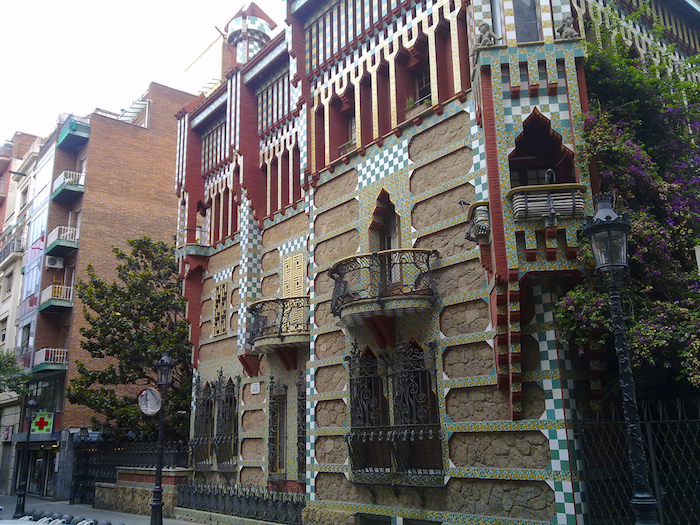
Casa Vicens, Barcelona. (c) J.J. Merelo. Flickr CC.
As the house is a private residence until now you can’t enter the building. This will change towards the end of 2017, when the house will be opened for the public late 2017. For now it is still worth to venture to the house to admire the outside of it. It is located at Carolines, no. 24 in the Gracia district.
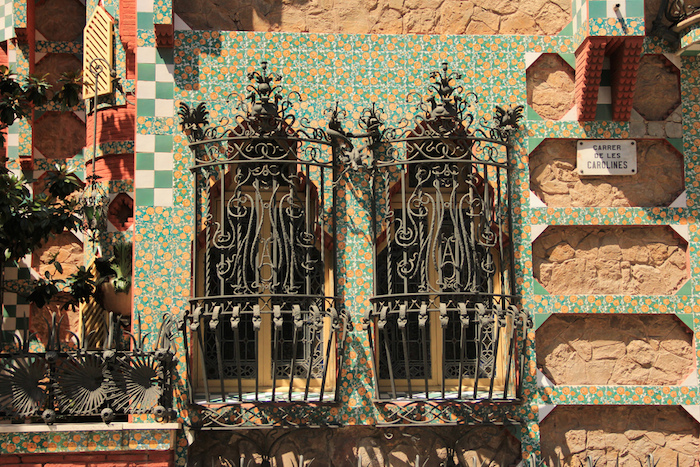
Casa Vicens, Barcelona. (c) Michela Simoncini. Flickr CC.
LIMITED TIME?
If you have limited time, we suggest you visit at least La Sagrada Familia, followed by a walk around Parc Guell and a visit to one of the mansions in the centre. Purchasing your tickets online can save a lot of time and hassle (and sometimes money). Especially in high season, which lasts pretty long here. We are sure you will get more out out of your weekend by buying your ticket online.
Have you seen Gaudi’s work in Barcelona already? Which site is your favorite?
The other articles for this month’s Art Smart Roundtable are:
- Christina of Daydream Tourist – Brunelleschi the Architect: More Than Florence’s Duomo
- Jenna of This Is My Happiness – Digging Deeper: Historic Architecture in California
- Alexandra of ArtTrav – Putting on a good face: Renaissance facades in Florence
